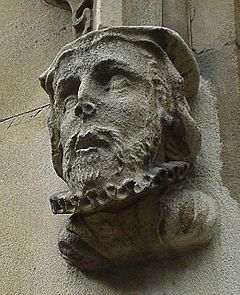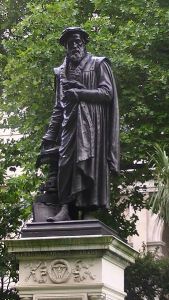5th August 1536.
‘Newe Testament fynesshed in the yere of oure Lorde God AMD XXX Vi’. (William Tyndale 1536).(1)
In 16th century Britain, the State determined your thought and practice in religion.
After Henry VIII had attacked the Protestant, Martin Luther, resulting in the Pope granting him the title of Defender of the Faith, he set his hounds, led by Thomas More, on tracking-down William Tyndale, who had been forced to flee abroad.(2)
It resulted Today in 1536 in the first of three documents authorising the deputisation of Ruard Tapper to exercise an Inquiry into William Tyndale, as the original person designated was indisposed.
Other than Tyndale’s moving account of his internment there are only three other official documents relating to his imprisonment and trial for heresy.
It resulted in his being strangled before being burned at the stake, in Belgium, after being ceremoniously deprived of his priesthood.(3)
His crime was to have translated the New Testament into English.
For much of his life he was hounded across western Europe by spies and agents from Henry VIII, the Pope, and the Holy Roman Emperor whose net finally closed in on him.
By which time to have known him, yet alone having read his works, would have meant death by torture and fire.
Tyndale had managed to smuggle from the Continent, in bales of wool and wine casks, the New Testament, which so enraged the Bishop of London that he bought up the entire stock of 6,000 and had them burned on the steps of St Paul’s Cathedral.
90% of the New Testament is Tyndale’s work giving to our everyday language, many words and phrases: ‘Under the sun’; ‘signs of the times’; ‘Lick the Dust’; Let their be light’; ‘My Brother’s keeper’; ‘the apple of his eye’; ‘the land of the living’; ‘Parting of the ways’, and dozens more.
Many of the expressions came from his Cotswold boyhood, whilst some came from Anglo-Saxon and Hebrew.
Tyndale’s monument is at North Nibley, Gloucestershire. There is also a statue on the Embankment in London and no doubt ignored oblivious of his work against tyranny.
The Tyndale family was also known as Hychyns (Hitchens) and it was as William Hychyns he was educated at Magdalen College School, Oxford, founded by William Waynflete in 1480 for the choristers of Magdalen.
(1) He gave to Protestantism a fire which was to give solace to later American slaves: ‘Let my People Go’, is from Tyndale’s (Exodus 5:1).
(2) Tyndale was to enter a series of disputatious writings with Thomas More from 1528 with More’s publication ‘A Dialoge concerning Heresyes’, eliciting a Treatise from Tyndale in 1530 ‘An Answere unto Sir Thomas More’s Dialoge’.
Two years later came More’s ‘The Confutacyon of Tyndales Answere (sic) 1532’, which is notable for the phrase where he asserts his adversary: ‘Feating conuayed himself out of the frying panne fayre into the fyre’: (Out of the frying pan into the fire’.
(3) Foxe in his Calendar of Martyrs sets Tyndale’s Commemoration of execution of burning at the stake, as October 6th 1536. However this is disputed and could have happened earlier.
Ref: Melvin Bragg, English was his Holy Grail, Saturday 1st June 2013. Daily Telegraph Review.
Ref: BBC2. The Most Dangerous Man in Tudor England. 9.00pm 6th June 2013.
Ref: wikamedia.org/image of statue.
Ref: wikipedia.org/other images


